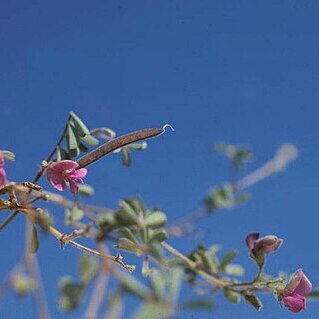Herbs, annual or perennial, procumbent or straggling, 20-30 cm tall. Stems thin and hard, ridged, densely spreading strigose. Stipules 3-4 mm. Leaves 7(-13)-foliolate; rachis 2-4 cm, including petiole 3-10 mm; leaflet blades narrowly obovate to oblanceolate, 1.2-2 × 0.4-0.8 cm, abaxially strigose, adaxially appressed pubescent, secondary veins 6 or 7 on each side of midvein and obscure, base cuneate, apex truncate to obtuse and cuspidate. Pseudoracemes terminal or opposite a leaf, ca. 2 cm, strigose, with 1-3 flowers. Pedicel 2.5-4 mm. Flowers ca. 6 mm. Calyx ca. 3 × 2 mm. Corolla white, yellow, or rarely pale pink; standard orbicular, pilose. Ovary with trichomes, with numerous ovules. Legume linear, 3.5-4 cm × ca. 4 mm, shortly strigose, apex slightly ascending curved and with a beak; style remnant sharply reflexed. Seeds 8-14 per legume, brown, oblong-rhomboid, ca. 4 × 3 mm, mottled. Fl. and fr. year-round. 2n = 22, 44.
A scrambling herb. It is mostly about 1 m long. Mostly it grows each year from seed but it can live for a few years. It has spreading hairs on the stems. There are 7-13 leaflets which are oblong or wedge shaped. They are 0.5-2 cm long by 2-6 mm wide. There is a point at the tip. The flowers are about 1 cm long in short clusters at the ends of stems or opposite the leaves. These stalks of flowers are 1-6 cm long. The flowers are white and pink or purple. The fruit are thin curved pods. which curve upwards towards the tip. Pods are 3.5-4 cm long and 3.3-4 mm wide. They are covered with short hairs. There are 8-14 seeds in the pods. The seeds are close together.


